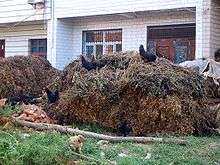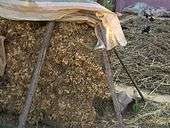Peanut production in China

Peanut production in China contributes to the national economy. China has been the world's largest producer of peanuts by a substantial margin since at least 2006.
The peanut was introduced to China by Portuguese traders in the 17th century and another variety was provided by American missionaries in the 19th century. During the 1980s, peanut production began to increase, a major factor being the household-responsibility system, which moved financial control from the government to the farmers.[1][2] By 2012 it was producing 16.7 million tonnes of peanuts annually.[3] Peanuts are often used to make peanut oil, a popular ingredient in Chinese, South Asian and Southeast Asian cuisine. Although China is by far the world's largest producer, the per capita consumption of peanuts in China as of 2009 was stated to be comparable to that of the United States.[4]
History
Archaeological finds of purported ancient carbonized remains of peanuts during excavations in China have led to the controversial claim that the groundnut is an indigenous crop, or that explorers from China or elsewhere in the Old World had discovered the Americas and introduced crops from there millennia before Columbus.[1][5][6] Most experts attribute the introduction of the peanut to the Portuguese during the Ming Dynasty. The peanut was introduced to Haicheng county in Fujian in the beginning of the 16th century. It then spread to Zhengjiang and beyond at the end of 16th century.[7] In the middle of the 19th century by American missionaries introduced more varieties.[1] In 1918, North China exported 70,000,000 pounds of peanuts, while South China imported 93,000,000 pounds. Historically, Honan and Chihli provinces have ranked next to Shantung in production.[8]
Local names
Peanut is known by different names in China. These include: Changshengguo (meaning "long-life fruit"), Luohuasheng (meaning "flower-born"), Didou (meaning "earth bean"), Xiangdou (meaning "fragrant bean"), Wuhuaguo (meaning "flowerless fruit"), and Qiansuizi (meaning "thousand-year-old offspring"). It is most commonly referred to as "Huashengmi 花生米" or just "huasheng 花生".[9]
Production

Peanuts are grown in seven regions of China based on ecological zoning, from the frigid North China to the humid region of South China, and from the eastern to western region. Temperatures in the areas producing peanuts range from −5 to 25 °C (23 to 77 °F). These regions are: Region I is "Virginia type north large peanut" region; Region II is known as "South Spring and autumn peanut area; in Region III the "Yangtze spring and summer peanut region"; Region IV is the "Yungui plateau peanut region"; Region V is the "Northeast early peanut region"; Region VI is the "Loess peanut region"; and Region VII is the "Northwest inland peanut region".[10] The five provinces where 70% of the crop is grown are Shandong, Henan, Hebei, Guangdong, and Jiangsu provinces.[11]
Peanut production in China has witnessed a phenomenal growth since 1961, particularly from the 1980s when the "Household Responsibility System" of cultivation became effective giving farmers the incentive of semi-private ownership rights, with the market economy giving a substantial advantage in increasing the yield per ha even though the area brought under the crop was not substantially changed; improved cultivation technology also helped in this increase.[12]
Production in 2004 totaled more than 13 million metric tons.[13] According to FAO statistics for 2013, the production of peanuts in China topped the list in the world with a yield of 17.02 million tons which amounted to a world share of 37.3%. This was contributed by 4.652 million ha ranking number 2 in the world but with highest yield rate of 3,659 kilograms per ha.[14] Compared to this, India, with a larger area of 5.25 million ha ranking number 1 in the world, was way behind China production-wise, recording only 9.472 million tons at 31st position due to a low yield rate of 1,804 kilograms per ha.[15]
Varieties
There are over 100 cultivars in China, but the diversity between them is relatively low. More than 70% of the cultivars were affirmed to contain co-ancestors ‘Fuhuasheng’ and ‘Shitouqi’. Southern cultivars are quite related to each other, and mostly of the subspecies fastigiata. Most northern cultivars are quite related, and mostly of the subspecies hypogaea.[16]
The variety group mostly exported by China is called ‘Hsuji’, which is a ‘Spanish’ type with a round shape.[17][18] Spanish groundnuts are smaller and oiler than the other common groups, and are mostly used shelled, in confectionery, salted as snacks, or in peanut butter.
References
- 1 2 3 Yao, G (2004). Peanut Production and Utilization in the People's Republic of China (PDF). University of Georgia. Archived from the original (PDF) on 2007-12-02.
- ↑ Butterworth, J; Wu, X. (January 3, 2004). China, Peoples Republic of Oilseeds and Products China's Peanut Sector (PDF). USDA Foreign Agricultural Service GAIN Report.
- ↑ "Table 13 Peanut Area, Yield, and Production". U.S. Department of Agriculture. Retrieved 14 June 2015.
- ↑ Georgiev, Vassil St. (6 July 2009). National Institute of Allergy and Infectious Diseases, NIH: Volume 2: Impact on Global Health. Springer Science & Business Media. p. 719. ISBN 978-1-60327-297-1.
- ↑ http://www.chinaheritagequarterly.org/briefs.php?searchterm=012_HAM_Briefs.inc&issue=012; accessed 7 November 2017
- ↑ https://publications.mi.byu.edu/fullscreen/?pub=1068; accessed 7 November 2017
- ↑ http://www.themua.org/collections/files/original/1e1032f7e85ff60933c1792804abf68e.pdf; accessed 7 November 2017
- ↑ United States Tariff Commission & Page 1920, p. 11.
- ↑ Yao 2004, p. 2.
- ↑ Yao 2004, pp. 4–7.
- ↑ Yao 2004, p. 11.
- ↑ Yao 2004, p. 8.
- ↑ Malik, Wadhwani & Kaur 2009, p. 163.
- ↑ "China: Peanuts, production quantity (tons)". factfish.com. Retrieved 14 June 2015.
- ↑ "India: Peanuts, production quantity (tons)". factfish.com. Retrieved 15 June 2015.
- ↑ Ren, Xiaoping et al.; 2014; Genetic Diversity and Population Structure of the Major Peanut (Arachis hypogaea L.) Cultivars Grown in China by SSR Markers; https://doi.org/10.1371/journal.pone.0088091
- ↑ Centre for the Promotion of Imports; Exporting groundnuts (peanuts) to Europe; https://www.cbi.eu/market-information/processed-fruit-vegetables-edible-nuts/groundnuts-peanuts-europe/; accessed 7 November 2017
- ↑ http://www.aldebaran.nl/wp-content/uploads/2017/10/the-Peanut-Market-Report-of-09-08-2017.pdf; accessed 7 November 2017
Bibliography
- Malik, Chander Parkash; Wadhwani, Chitra; Kaur, Bhavneet (2009). Crop Breeding and Biotechnology. Pointer Publishers. ISBN 978-81-7132-590-0.
- United States Tariff Commission; Page, Thomas Walker (1920). Survey of the American Peanut Industry (Public domain ed.). U.S. Government Printing Office.
- Yao, Gang (2004). "Peanut production and Utilization in the People's Republic of China" (PDF). University of Georgia College of Agricultural and Environmental Sciences. Retrieved 15 June 2015.